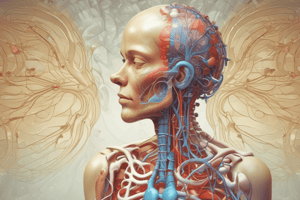Podcast
Questions and Answers
What is the primary energy source during short-term high-intensity exercise?
What is the primary energy source during short-term high-intensity exercise?
- Glycogen
- Phosphagens (correct)
- Free Fatty Acids
- Glucose
Which system produces 38 ATP from the breakdown of glucose?
Which system produces 38 ATP from the breakdown of glucose?
- Phosphagen System
- Glycolysis
- Oxidative Phosphorylation (correct)
- Fermentation
What is the term for the amount of extra oxygen required by muscle tissue during recovery from vigorous exercise?
What is the term for the amount of extra oxygen required by muscle tissue during recovery from vigorous exercise?
- Anaerobic threshold
- Oxygen debt (correct)
- Oxygen surplus
- Aerobic capacity
During which type of exercise is oxygen not required?
During which type of exercise is oxygen not required?
What is the byproduct of glycolysis?
What is the byproduct of glycolysis?
How much ATP is produced during the phosphagen system?
How much ATP is produced during the phosphagen system?
What is the primary energy source during long-term low-intensity exercise?
What is the primary energy source during long-term low-intensity exercise?
Which system has a duration of 15 seconds to 2 minutes?
Which system has a duration of 15 seconds to 2 minutes?
What is EPOC an alternative terminology for?
What is EPOC an alternative terminology for?
Why does our respiratory rate increase after stopping heavy exercise?
Why does our respiratory rate increase after stopping heavy exercise?
What is the formula to calculate oxygen deficit?
What is the formula to calculate oxygen deficit?
What is the primary reason for EPOC during the recovery period?
What is the primary reason for EPOC during the recovery period?
What happens to an unacclimatized aviator at an altitude of 23,000 feet?
What happens to an unacclimatized aviator at an altitude of 23,000 feet?
Why must an airplane be pressurized above 50,000 feet?
Why must an airplane be pressurized above 50,000 feet?
During exercise, which of the following occurs in the oxygen-hemoglobin dissociation curve?
During exercise, which of the following occurs in the oxygen-hemoglobin dissociation curve?
What is one of the factors that stimulates breathing during exercise?
What is one of the factors that stimulates breathing during exercise?
What is the effect of exercise on cardiac output?
What is the effect of exercise on cardiac output?
What is the result of increased ventilation during exercise?
What is the result of increased ventilation during exercise?
What is the role of skeletal and respiratory pumps during exercise?
What is the role of skeletal and respiratory pumps during exercise?
What is the effect of exercise on the peripheral chemoreceptors?
What is the effect of exercise on the peripheral chemoreceptors?
What is the effect of exercise on stroke volume?
What is the effect of exercise on stroke volume?
What is the role of local vasodilation during exercise?
What is the role of local vasodilation during exercise?
Flashcards are hidden until you start studying
Study Notes
O2 Consumption, CO2 Production, and Ventilation
- Arterial blood has a higher Pao2 and lower Paco2 compared to venous blood
- Pulmonary blood flow increases during exercise, shifting the O2-hemoglobin dissociation curve to the right
- Despite increased CO2 production during exercise, PaCO2 remains normal due to increased ventilation
Muscle Metabolism during Exercise
- Phosphagens provide immediate energy (1 ATP) during exercise
- Glycolysis generates 2 ATP from glycogen through anaerobic respiration
- Oxidative phosphorylation generates 38 ATP from glucose, fatty acids, and amino acids through aerobic respiration
Oxygen Debt and EPOC
- Oxygen debt is the amount of extra oxygen required by muscle tissue during recovery from vigorous exercise
- EPOC (Excess Post-exercise Oxygen Consumption) is another term for oxygen debt
- Oxygen debt is measured as the difference between oxygen required during exercise and at rest
- During exercise, oxygen deficit occurs when oxygen demand exceeds supply, leading to anaerobic respiration
Importance of Recovery
- Recovery is necessary for:
- ATP and creatine phosphate replacement
- Removal of accumulated lactic acid
- Myoglobulin replacement of O2
- Glycogen replacement
- Heart rate recovery
- Respiration recovery
Human Tolerance at Different Elevations
- At 12,000-15,000 feet, a normal person becomes lethargic and loses mental alertness
- At 23,000 feet, an unacclimatized person becomes comatose within 20-30 minutes
- With pure oxygen, a pilot can ascend to an altitude of about 47,000 feet
- Above 50,000 feet, an airplane should be pressurized
Respiratory Physiological Responses
- Respiratory response to exercise:
- Increase O2 consumption 10-20 times at rest
- Pulmonary hyperventilation
- Increased cardiac output
- Local vasodilation of muscles
- Shift of O2-hemoglobin dissociation curve to the right
- Factors that stimulate breathing during exercise:
- Signals from cerebral and afferent signals from joint and muscle mechanoreceptors
- Increased plasma K+ and body temperature that stimulate peripheral chemoreceptors
Studying That Suits You
Use AI to generate personalized quizzes and flashcards to suit your learning preferences.




